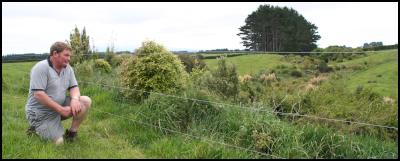Busy Farmer Gets His Plants Sorted

Adrian Hofmans inspects
four-year-old riparian planting along a tributary of the
Waingongoro River.
When Adrian Hofmans first got into riparian management, it didn’t take long for him to decide he needed help.
“Although I was new to it, I realised it was something we had to get right,” he says. “But it was a very stressful springtime and I was scratching my head about all these plants and how they should be planted.”
So he turned to a contractor, beginning an enduring partnership that has so far seen 70% of the 200 ha dairy farm’s river and stream banks planted out.
That amounts to a grand total of 4,000 native plants –as well as hundreds of pines and poplars planted around the farm to provide shelter and shade for stock. These will eventually be harvested.
There’s also an extra 8 km of fencing along streams and the river.
Mr Hofmans says he’s learned a thing or two about plants in the six years he’s working with a Taranaki Regional Council Land Management Officer to implement a riparian management plan. But it’s also been invaluable to draw on the contractor’s knowledge of which native species are best suited to different areas on the farm, which backs on to the Waingongoro River near Eltham.
“And they do the pre-spraying, the planting and come back and spray again,” he says.
“It’s taken off our hands and it’s all at a time when we are really busy anyway. In that first year I found I’d be thinking ‘we’ll do it tomorrow’, then when tomorrow came I’d be thinking ‘we’ll do it tomorrow’, and so it went on.”
Mr Hofmans didn’t have to look far to find his contractor – “he’s local and I know him” – but the Taranaki Regional Council can provide advice about using contractors as part of its work promoting and preparing riparian management plans.
For Mr Hofmans, it makes economic sense to factor in contracted riparian planting when preparing the annual work plan and budget. “It’s well worth it and it’s tax-deductable”
The Taranaki Regional Council promotes riparian planting because of its proven benefits in enhancing water quality. Properly established riparian buffers filter sediment and pollution, and reduce the speed of run-off, which moderates stream flows and reduces flooding. Riparian buffers also provide food and shelter for wildlife and corridors for plants and birds.
Streamside vegetation also reduces water temperatures and supplies food for aquatic insects that in turn provide food for fish.
Mr Hofmans also sees big stock-management benefits. “The last thing you want to be doing at 4 am is peering down stream beds and gullies to see if there’s an animal you’ve missed.”
He sees other benefits that are less tangible but still important: “I’ve really noticed the birds coming back – silvereyes near the flaxes or anything with flowers; native pigeons down by the river.”
Also important – and unexpected – is the aesthetic improvement. “I’ve realized the farm seems a more peaceful place with lots of trees planted around it.”
Another bonus: In some areas on the farm, native plants are self-regenerating behind that 8 km of new riparian fencing. “It’s been interesting to watch that,” says Mr Hofmans.
Taranaki Regional Council Land Services Manager Don Shearman says riparian planting can be an extra job for farmers in the early spring and Mr Hofmans’ experience shows that bringing in a contractor can be a cost-effective solution for planting large numbers.
Farmers can obtain free riparian management plans from the Council, whose staff prepare them using GIS technology. Suitable plants can also be supplied at cost. For more information, call 06 765 7127 and ask to talk to a Land Management Officer.
ENDS


 Gordon Campbell: On The New Pope, And The Israeli Attack On Peter Davis
Gordon Campbell: On The New Pope, And The Israeli Attack On Peter Davis Queer Endurance in Defiance: Wellington Queer Communities Protest Against NZ First’s Anti-Trans Bill
Queer Endurance in Defiance: Wellington Queer Communities Protest Against NZ First’s Anti-Trans Bill Water New Zealand: Stormwater 2025 - Tackling Flooding And Storms To Build A Climate-Resilient Future
Water New Zealand: Stormwater 2025 - Tackling Flooding And Storms To Build A Climate-Resilient Future New Zealand Labour Party: Labour Asks Why Govt Is Silent On Gaza
New Zealand Labour Party: Labour Asks Why Govt Is Silent On Gaza Transport Accident Investigation Commission: Near-Collision Highlights Safety Lessons For All Busy, Unattended Aerodromes
Transport Accident Investigation Commission: Near-Collision Highlights Safety Lessons For All Busy, Unattended Aerodromes Green Party: Wildlife Law Change A Deep Betrayal Of Public Trust
Green Party: Wildlife Law Change A Deep Betrayal Of Public Trust NZCTU: Unions Launch Petition To Protect Pay Equity
NZCTU: Unions Launch Petition To Protect Pay Equity


